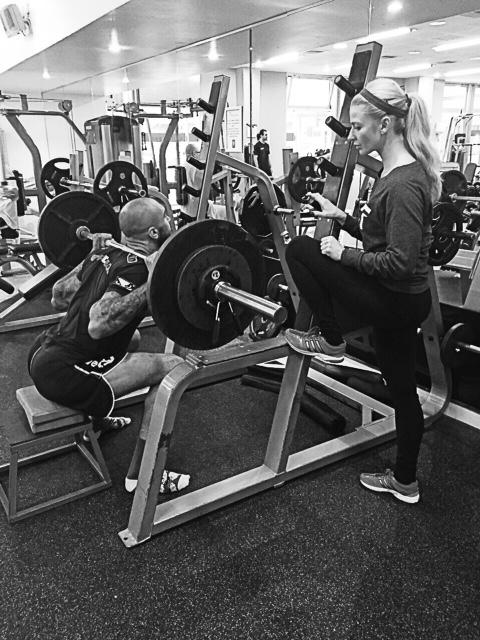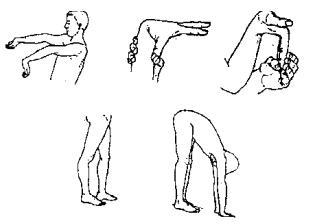
STRENGTH TRAINING AND JOINT STABILITY (Injury prevention for Combat Athletes)
By Sabina Skala
It is not a secret that I am a huge fan of serious strength training for combat athletes. The reason being is not only that stronger and well conditioned fighter stands a greater chance of winning a fight (that providing technical skills are equal), but also, and even more importantly Strength training is a great tool that will prolong fighters carrier. It creates that strong internal injury prevention shield that cannot be underestimated by pro-fighters at the top of the game. Development of joint stability and strength in the joints is a very important component of strength training. If you train female athletes, or (as Leon Chaitow & Judith De Lany mention in Clinical Applications of Neuromuscular Techniques Volume 1) also athletes of African, Asian and Arab origin you may have notice that their joints can be a bit loose. Basically their ligaments have more “give” than an average person. Just to clarify we all have some degree of congenial laxity, some people have naturally stiff joints, others – very loose.
 There is a certain degree of danger in cases where excessive joint laxity is present. I trained a very talented young Judo athlete, who when she came to me at the age of 17 already had 2 ACL replacement surgeries. She was just unlucky that genetically her ligaments had a lot more “give” than the average person. Quite a big % of female athletes suffer from joint hypermobility – excessive congenial laxity – which means their joints are hypermobile, unstable and prone to injuries. Athletes like that don’t need that much stretching, what they need is more stability. Well designed strength training is crucial here, especially if there is a lot of power movements required for the sport, as well as single leg activities or placing joints in unnatural position (all three present in combat). If you have someone, who is lax and start statically stretching them a lot, it is only going to make the things worse. This is actually a very common mistake trainers do with their athletes, as a lot of lax athletes actually feel “tight” and ask for static stretching. However this tightness is just a way the body copes with instability and tries to create stability in the areas which are chronically unstable. This way the loose athletes would be much better off if they spent time on improving the joint stability to get back to efficient movement than on stretching.
There is a certain degree of danger in cases where excessive joint laxity is present. I trained a very talented young Judo athlete, who when she came to me at the age of 17 already had 2 ACL replacement surgeries. She was just unlucky that genetically her ligaments had a lot more “give” than the average person. Quite a big % of female athletes suffer from joint hypermobility – excessive congenial laxity – which means their joints are hypermobile, unstable and prone to injuries. Athletes like that don’t need that much stretching, what they need is more stability. Well designed strength training is crucial here, especially if there is a lot of power movements required for the sport, as well as single leg activities or placing joints in unnatural position (all three present in combat). If you have someone, who is lax and start statically stretching them a lot, it is only going to make the things worse. This is actually a very common mistake trainers do with their athletes, as a lot of lax athletes actually feel “tight” and ask for static stretching. However this tightness is just a way the body copes with instability and tries to create stability in the areas which are chronically unstable. This way the loose athletes would be much better off if they spent time on improving the joint stability to get back to efficient movement than on stretching.

How can you recognize the athlete you train is lax? The easy way to assess the general hypermobilty in a gym environment is to use the Beighton hypermobility scale. The screen consists of 5 tests and is scored as follows (out of 9):
- One point if while standing forward bending you can place palms on the ground with legs straight
- One point for each elbow that bends backwards
- One point for each knee that bends backwards
- One point for each thumb that touches the forearm when bent backwards
- One point for each pinky that bends backwards beyond 90 degrees.
 If the fighter you train scores high (4+ out of 9) it doesn’t matter if he/she looks “big” and “strong”, they don’t need aggressive static stretching, probably very little stretching altogether, instead they need to work on stability and mobility within the required range. If they complain at feeling tight – massage and foam rolling will be a better idea than a lot of static stretches. The assumption that big, muscular guys are tight may not always be correct. Don’t get me wrong, I still use static stretches with some of my clients, with some I don’t use them at all. Each case is unique, and you need to know why you include certain exercises and stretches in your program. At the end of the day, remember that you’re better off being too tight than too loose, therefore if you’re unsure about something, don’t stretch it. Each body is unique, adapt the training, the mobility and the stretching to the athlete’s needs.
If the fighter you train scores high (4+ out of 9) it doesn’t matter if he/she looks “big” and “strong”, they don’t need aggressive static stretching, probably very little stretching altogether, instead they need to work on stability and mobility within the required range. If they complain at feeling tight – massage and foam rolling will be a better idea than a lot of static stretches. The assumption that big, muscular guys are tight may not always be correct. Don’t get me wrong, I still use static stretches with some of my clients, with some I don’t use them at all. Each case is unique, and you need to know why you include certain exercises and stretches in your program. At the end of the day, remember that you’re better off being too tight than too loose, therefore if you’re unsure about something, don’t stretch it. Each body is unique, adapt the training, the mobility and the stretching to the athlete’s needs.
One more point - Stiffness can actually be a good thing. It has gained an unjustly bad reputation, as it is a crucial part in enhancing ones athletic ability and keeping healthy joints.
As with laxity – the problem exists only if someone is excessively lax, same goes with stiffness, - we are in trouble only if the athlete is excessively stiff. If you apply stiffness to specific joints it can prove to be a desired thing, as it will prevent the movement at a range when desired. Hence we can refer to that kind of stiffness as stability.
As a former competitive athlete Sabina believes that each is truly responsible for the performance potential and that we all are capable of limitless possibilities when we put our mind and hard work to it. Contact info: [email protected] or via contact form www.cjscombat.com




